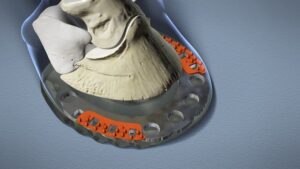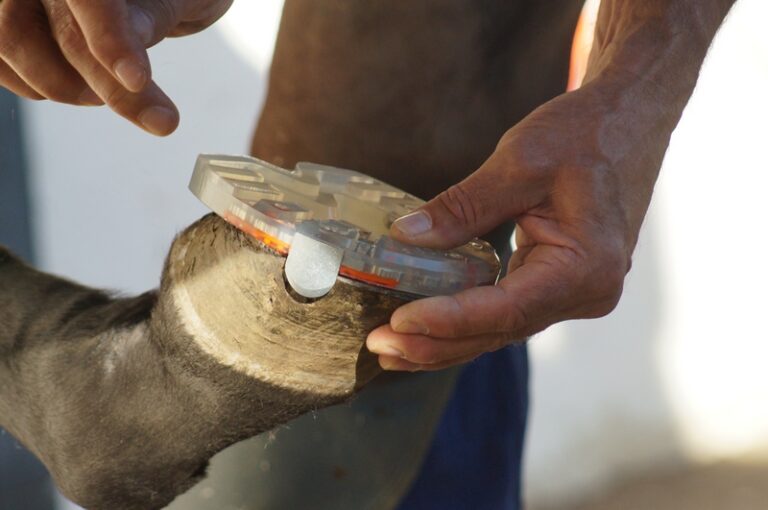Jess Morton looks at composite horseshoes, how they came to be, their benefits and some of the brands on the market today. This is her own review not a sponsored post, to provide you with some information about these new, lightweight horseshoes.
According to the history books, the first form of nail-on hoof protection appeared around 400 BC in ancient Italy. Horses were shod then, just like today, to stop the hoof wearing down faster than it could grow. By applying protection, working horses could cover more ground and work for longer periods of time compared to horses without protection. The value of horses in ancient times depended to a great extent upon his feet, so the invention of the horseshoe revolutionized transportation, trade, and warfare around the world.
For horses requiring additional protection or to correct conformation faults that could cause lameness, horseshoes are still a useful tool. But not all horses do well with metal nailed to their hooves and science tells us that the natural design of a horse’s hoof really can provide all the protection and support a horse’s needs.
But while some horses with strong, healthy feet can easily transition to a ridden life without shoes, others need some extra help getting there.
Plastic and rubber may not be the first thing you think of when it comes to horseshoes, but these lightweight and flexible materials have truly revolutionized hoof protection over the past decade. Still not as popular as traditional metal shoes, composite shoes are now more affordable and accessible than ever before. But what are they, and how do they work exactly?

No Hoof, No Horse Still Rings True Today.
I was given the chance to try out alternative shoes when, after retiring my former guide horse, I moved to a property with an open living system. Since all the horses lived together as part of one large herd, he needed to have his shoes pulled. That was fine with me, as I hoped to leave him barefoot all year round now that he was working less.
I worked with a barefoot trimmer for almost a year trying to transition him to life without shoes. The trimmer was resolute that he could make the switch, but month after month, my horse, who had been shod all his life, struggled. Because of his foot soreness, our rides were limited to short sessions in the school or slow walks around the property. He was bored; I was bored. We needed a different solution.
My farrier suggested I try fitting him with a set of composite shoes, which he said were a great “meet-in-the-middle” approach for owners that want to keep their horses barefoot with a bit of extra support and protection. Luckily, since the shock-absorbing design of composite shoes reduces the risk of paddock injury, I was given the ok at the agistment yard to shoe my horse.

Plastic Shoes For Horses?
Composite horseshoes (also known as plastic horseshoes) have been around for two decades now. Typically made from several composites, i.e. plastic or rubber, they function in a way that mimics a barefoot hoof. Some composite shoes have a steel or aluminum core and others are purely synthetic.
Just like traditional shoes, they come in a range of sizes and styles, and they can be nailed or glued to the hoof. Your farrier can create custom fits and add padding and extra support when required.
Thanks to their shock-absorbing qualities, they can be hugely beneficial in reducing discomfort from chronic conditions such as arthritis, laminitis, and navicular disease. Composite shoes can work better than going barefoot or barefoot with boots, especially for horses with thin soles or poor hoof health transitioning to life without shoes.
I used Duplo Composite Shoes on my horse. They have a synthetic outer and a steel inner core with protection and support for the frog and sole. The shoeing process was easy and took no longer than a normal shoeing appointment. The cost was roughly double what I normally pay.

When I returned my to the pasture after his shoeing, I could see an improvement in the way he moved. You know that feeling when you put on a really fancy pair of running shoes with a lightweight sole? Yeah, well, that’s how I imagine my horse felt. His gait transformed from short and choppy to long and swinging. Back in the field he zoomed about like a loon, something he hadn’t done in ages. It was a great start.
All Terrain Traction.
Popular with endurance riders, composite shoes have tread underneath them like a pair of running shoes. They are bouncy and shock-absorbent and when used on hard surfaces they hardly make a noise (perfect for horseback spies). I cross a lot of rivers on my rides, and the footing is usually rocky and slippery. The current can be strong in the river after rain, so having good traction when we step into the water is important. Composite tread is far superior to steel on rocks – rather than slipping, they seem to grip like a natural hoof. My horse is far more confident entering rivers now.
Sliding Stops? Not With This Shoe.
A study made published in the American Journal of Veterinary Research earlier this year evaluated hoof slippage in 4 different horseshoes and found that horses wearing composite shoes had better braking capacity than those wearing metal shoes. The anti-slide design of composites is supposed to mimic that of a barefoot horse (but with protection and support for the sole and frog), and is especially noticeable on asphalt and cobblestones. If you have ever been unlucky enough to have a horse slide out underneath you on a road, you will probably agree with me that this feature alone is worth the extra cost.

Circulation And Hoof Health.
Traditional horseshoes are nailed to the outer wall of the hoof, which means the frog and sole of the foot are lifted off of the ground. Barefoot horses naturally share the weight of their body around many parts of the hoof surface–including the frog, sole and inner wall. This boosts healthy circulation and tissue growth. The anatomical design of Duplo shoes means the frog is supported by a bar at the heel of the shoe, and this stimulates the entire hoof, not just the outer wall.
Better Than Barefoot, Nah. Better than Steel – Probably.
Most of us agree that barefoot is the best option for horses, but if you can’t keep your horse unshod for whatever reason, composite shoes are a great alternative.
After three months of testing out these shoes on all sorts of surfaces and in all sorts of weather, I can say that I have been converted. This year, I never imagined my horse would still be fit and sound enough to be riding the sort of trails we are doing, but actually, he has never moved better than he does now.
Price wise, I initially thought the hefty fee was steep but considering one set of shoes has lasted me three months (they were reset at 6 weeks) then I think they may actually wear better than steel shoes. The overall cost is worth it when I look at how happy my horse is. He waits for me at the gate now and seems to really enjoy our little adventures.
As someone that rides mostly outside of the arena, the lightweight flexible design and enhanced traction is a huge plus for me too. My horse is surer when crossing cobblestones or asphalt roads and riverbeds.
While I would always choose composite shoes over steel in the future, my end goal is still to have my horse totally barefoot next year, and use boots for trail riding. In the meantime, composites allow me to keep him fit and healthy while his hooves regenerate. It’s a win-win situation for us both.

Alternatives To Steel Horseshoes
There are a myriad of composite designs on the market manufactured by different companies around the world. The technology and materials just get better and better each year. Check out a few of our favorites:
https://duplo-frank.de/en/duplo-composite-horseshoes Duplo horseshoes are a plastic/steel shoe that protects the hoof capsule and allows natural barefoot movement. These were the shoes I used in the trial. They have been around for more than twenty years and are popular in Europe and the Americas.
https://www.eponamind.com/eponashoe/ A flexible composite design that allows the whole hoof to flex, and is one step closer to barefoot than rigid metal horseshoes.
https://www.easycareinc.com Composite shoes designed to allow the hoof to expand and contract, both laterally and vertically as nature intended.
https://ollov.com Composite shoes that provide a combination of stability and comfort with a steel core and rubber outer.
https://www.polyflexhorseshoes.com/ A polyurethane model designed to enhance the natural shock absorbing mechanism of the hoof.



